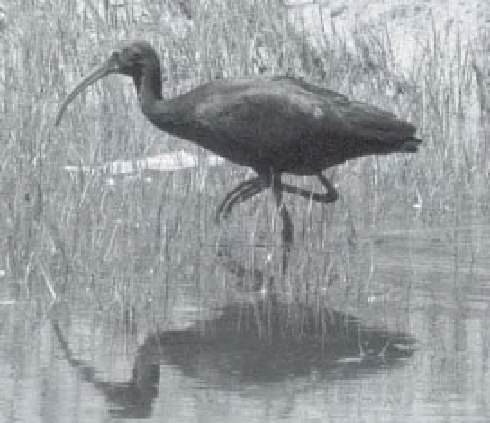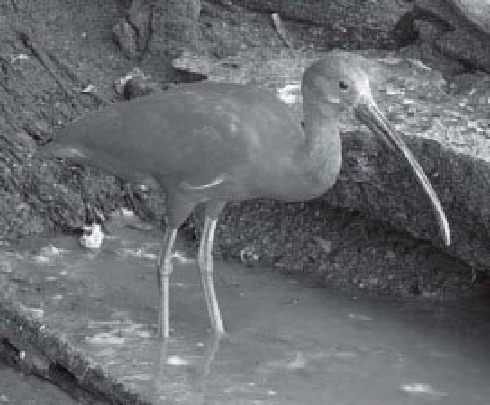Geoscience Reference
In-Depth Information
A
B
Figure 7-23.
American avocet (
Recurvirostra
americana
) pauses after stirring up the water in a
shallow marsh at Quivira National Wildlife Refuge,
Kansas, United States. The copper-colored head and
striking black-and-white pattern on its back are quite
distinctive. Photo by J.S. Aber.
upward (Fig. 7-23). It uses the beak to sweep
back and forth in muddy water to stir up aquatic
insects and vegetation (Collins, Collins and
Gress 1994). Ibises have long, strong, curved
beaks to probe deeply for insects, crayi sh, crabs
and mollusks (Fig. 7-24).
Flamingos (family Phoenicopteridae) are par-
ticularly showy birds; six species are recognized
(Table 7-2). They have long legs and long, l ex-
ible necks; frequently they stand on a single leg.
Flamingos are i lter feeders; they scoop up mud
and strain out phytoplankton, zooplankton, and
small invertebrates
-
mollusks, crustaceans, and
brine shrimp. Flamingos favor salt lakes, where
such food is abundant because i sh are not
present to eat the invertebrates (Dugan 2005).
Color ranges from gray to light pink to bright
red depending on age and diet (New World
Encyclopedia 2008). The great blue heron (see
Fig. 7-20) is a large predatory shorebird, feeding
primarily on i sh, amphibians and reptiles as
well as small birds and mammals. It stands
motionless in shallow water waiting for an
unsuspecting prey animal to come within range,
Figure 7-24.
Ibises possess long, strong, curved beaks
for deep probing. A. White-faced ibis (
Plegadis chihi
)
stalks through a shallow marsh. Photo by J.S. Aber and
S.W. Aber, western Nebraska, United States. B. Scarlet
ibis (
Eudocimus ruber
) seeks crabs and mollusks in
mangrove thickets and coastal mudl ats (see Color Plate
7-24B). Photo courtesy of M. Buchele, Brazil.
then the long, sharp beak is used to spear the
prey.
Ducks and geese are the most commonly
recognized waterfowl the world over, and some
have been domesticated. Ducks and geese are
particularly abundant in the prairie pothole
region of the recently glaciated portion of the
Great Plains in the United States and Canadian
Prairie. Millions of undrained depressions
provide all manner and sizes of wetland habitats
that may support as many as 140 ducks per







